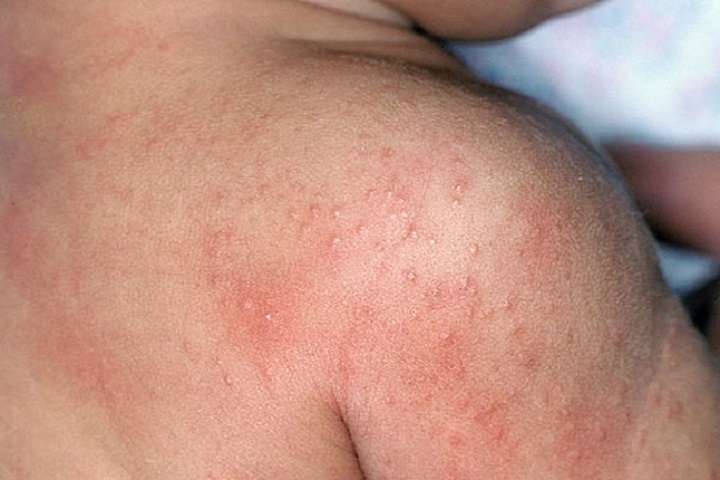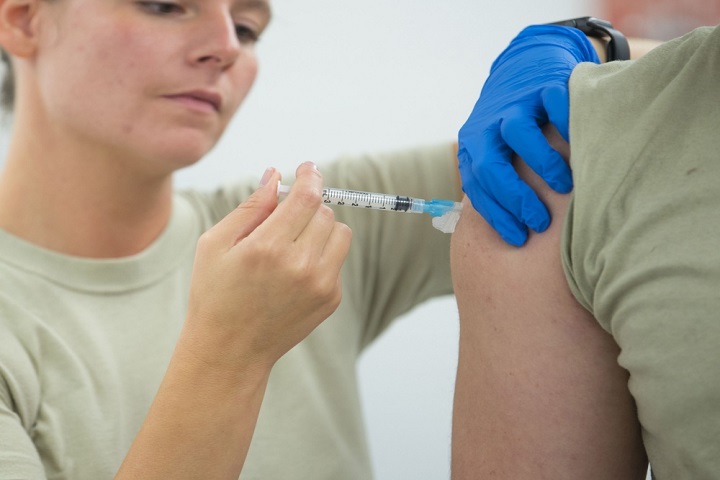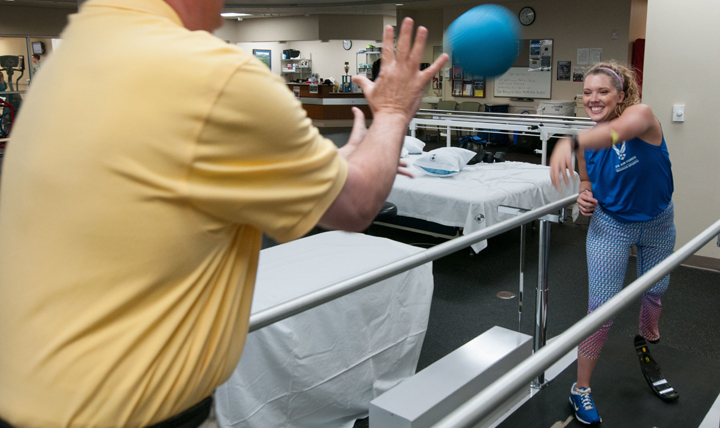
Heat rash is common when the mercury climbs

Heat rash is common in the warm summer months, but military personnel and amputees may be especially at risk. (Courtesy photo)
FALLS CHURCH, Va. – Heat rash is common in the warm summer months, but military personnel and amputees may be especially at risk. The common term “heat rash,” also known as “prickly heat,” and the medical term “miliaria,” usually refer to a collection of small, two- to four-millimeter reddish bumps on the skin. These are caused by a temporary blockage of the sweat glands, resulting in skin irritation.
Any activity or condition that induces sweating can lead to heat rash, including hot and humid environments, physical activity, fever, and clothing or gear blocking or rubbing the skin. Anyone can be affected, including children and adults of both sexes, said Navy Capt. Peter Shumaker, chairman of the department of dermatology at Naval Medical Center San Diego.
He noted that treatment and avoidance of heat rash focus on decreasing the factors that worsen sweating – for example, by moving to a cooler (air-conditioned) environment or wearing loose, breathable clothing. Showering or bathing to cool the skin can also help resolve heat rash symptoms.
When the symptoms include itching or irritation, mild topical corticosteroids such as hydrocortisone may be used, as well as topical antibiotics. “It is also important to seek medical attention for persistent cases or those with severe symptoms, to ensure the appropriate diagnosis is made,” Shumaker said.
For amputees, sweating and skin blockage are a regular part of life. Shumaker said the rubber liners that are worn under prosthetic devices are like wearing a diving suit for 12 to 18 hours per day. For such patients, additional interventions are often required to reduce sweating and improve the fit and comfort of their prosthetics.
These interventions may include procedures once thought to be only cosmetic. Military dermatologists such as Shumaker, who has more than a decade of experience treating patients injured in wartime, have played a major role in these efforts.
“Dermatologists in uniform have been instrumental in repurposing existing technology that is often used for cosmetic purposes in the civilian world, to serve the needs of our wounded warriors,” he said.
For example, Shumaker continued, laser hair removal and injection of botulinum toxin (Botox) to reduce sweating have been game-changing advances that are becoming routine in military treatment facilities, yet are still relatively uncommon in the civilian world.
Sweat reduction is one way those with amputations can lower their chances of developing heat rash. Particularly in the summer months or in hot climates, Shumaker suggests taking periodic breaks from the prosthetic in a temperature-controlled environment. In addition, daily application of a non-irritating roll-on antiperspirant under the prosthetic liner may also be helpful. If this is not enough, he notes, physicians with appropriate expertise may use treatments such as Botox injections for temporary relief from excessive sweating.
“Not all Botox injections and laser treatments are for cosmetic purposes,” said Shumaker. “We shouldn’t just assume they are frivolous procedures – they are procedures that can add significantly to the quality of life of our wounded warriors.”
The things head lice carry: Stigma and hassle, but no harm
Article
7/30/2018

Lice – a common affliction in school children – are gross but harmless
Food Allergy
Infographic
7/24/2018

Individuals with a history of food-allergy anaphylaxis or a systemic reaction to food do not meet military accession or retention standards and require a waiver in order to serve in the military. First-line treatment for anaphylaxis includes rapid administration of epinephrine.
Acute Injuries
Infographic
7/24/2018

Service members in the U.S. Armed Forces frequently engage in high levels of physical activity to perform their duties, and such activity can potentially result in training- or duty-related injury. This report summarizes the incidence, trends, types, external causes, and dispositions of acute injuries among active component U.S. service members over ...
Preparing for travel can prevent illness
Article
7/17/2018

Experts encourage travelers to be proactive about their travel medicine needs, including learning about the health risks associated with the destination and checking with their doctor to make sure they’re in good health
Living with aphasia and the long road to regain language capabilities
Article
6/11/2018

Roughly 1 million Americans currently have aphasia, a condition that impairs the ability to express and/or understand language, and nearly 180,000 Americans are diagnosed with it every year.
Deep vein thrombosis: What you need to know
Article
4/9/2018

Everyone’s potentially at risk, vascular surgeon says
‘Kissing disease’ exhausting, but it strikes only once
Article
2/15/2018

Mononucleosis: Learn how virus spreads, who’s most vulnerable
Rocky and Elmo want providers to "Watch. Ask. Share."
Article
2/12/2018

How DHA teamed with Sesame Street to help care for military families
Caring for skin goes deeper than applying lotion
Article
2/6/2018

The many critical roles of a military dermatologist
Guarding the health of service members
Article
1/9/2018

The vital role of the Public Health Division
MSMR Vol. 25 No. 1 - January 2018
Report
1/1/2018
A monthly publication of the Armed Forces Health Surveillance Branch. This issue of the peer-reviewed journal contains the following articles: Review of the U.S. military's human immunodeficiency virus program: a legacy of progress and a future of promise; Update: Routine screening for antibodies to human immunodeficiency virus, civilian applicants ...
MSMR Vol. 25 No. 3 - March 2018
Report
1/1/2018
A monthly publication of the Armed Forces Health Surveillance Branch. This issue of the peer-reviewed journal contains the following articles: Update: Malaria, U.S. Armed Forces, 2017; Surveillance for vector-borne diseases among active and reserve component service members, U.S. Armed Forces, 2010–2016; Diagnostic evaluation of military blood donors ...
MSMR Vol. 25 No. 6 - June 2018
Report
1/1/2018
A monthly publication of the Armed Forces Health Surveillance Branch. This issue of the peer-reviewed journal contains the following articles: Update: Malaria, U.S. Armed Forces, 2017; Surveillance for vector-borne diseases among active and reserve component service members, U.S. Armed Forces, 2010–2016; Diagnostic evaluation of military blood donors ...
MSMR Vol. 25 No. 5 - May 2018
Report
1/1/2018
A monthly publication of the Armed Forces Health Surveillance Branch. This issue of the peer-reviewed journal contains the following articles: Update: Malaria, U.S. Armed Forces, 2017; Surveillance for vector-borne diseases among active and reserve component service members, U.S. Armed Forces, 2010–2016; Diagnostic evaluation of military blood donors ...
MSMR Vol. 25 No. 4 - April 2018
Report
1/1/2018
A monthly publication of the Armed Forces Health Surveillance Branch. This issue of the peer-reviewed journal contains the following articles: Update: Malaria, U.S. Armed Forces, 2017; Surveillance for vector-borne diseases among active and reserve component service members, U.S. Armed Forces, 2010–2016; Diagnostic evaluation of military blood donors ...






















.png)











No hay comentarios:
Publicar un comentario